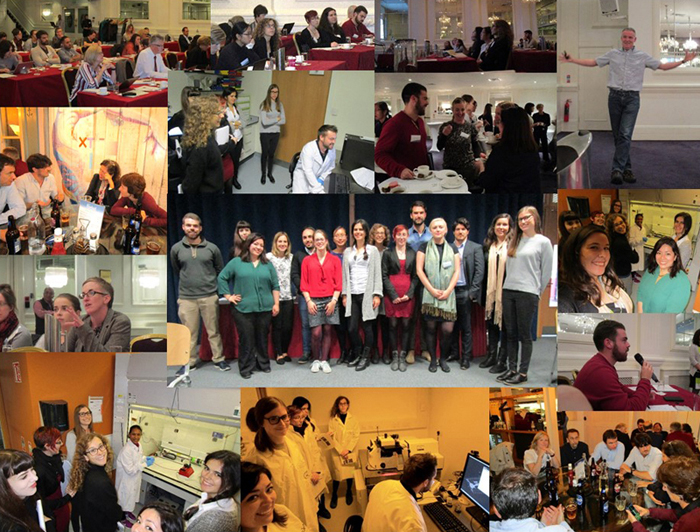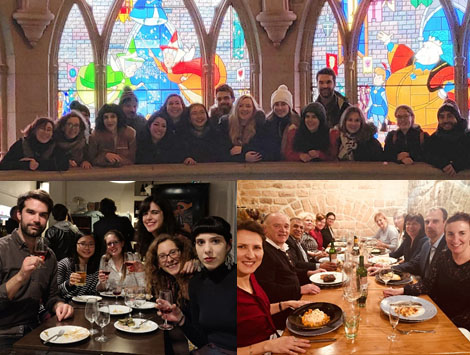BMT Events
| Research Summer School 4 and Networking Conference at NECTAR 2019 | |
|
|
|
| Training Workshop: How to find a job after your PhD by Association Bernard Gregory (ABG) | |
| Invited Speakers | |
| James Phillips (UCL) | Tissue engineering to repair the nervous system |
| Ben Newland (Cardiff University) | Biomaterial toolbox for studying brain pathology, function and repair |
| Eilís Dowd (NUIG) | Cellular brain repair for Parkinson’s Disease: Is the answer in the (biomaterial) matrix? |
| Erin Lavik (UMBC) | Biomaterials for modelling and repairing the CNS |
| Anne Rosser (Cardiff University) | Cell therapy for Huntington’s Disease: lessons learned and next steps |
| Deidre Hoban (Lund University) | Development of a novel accelerated α-synuclein rat model of Parkinson’s Disease to assess transplantation of human embryonic stem cell derived dopaminergic neurons |
| Su-Chu Zhang (Nanyang Technological University Singapore) | Stem cell therapy for neurological disorders |
| Erwan Bezard (University Bordeaux) | Cell therapy for Parkinson’s Disease |
| Azuka Morizane (Kyoto University) | HLA matched grafting in primates with induced pluripotent stem cells |
| Ponsaerts Peter (University Antwerpen) | Innate and adaptive immune recognition of autologous and allogeneic cell transplants in the central nervous system of rodents: harmless side effect or therapeutic inflammation? |
| Romina Aron Badin (CEA Paris) | Cell therapy in HD in HLA matched and non-matched NHP recipients |
| Malú Tansey (Weston Brain Institute US) | Neuroinflammation in neurodegenerative disease |
| Johan Jakobbsson (University Lund) | Modelling impaired autophagy in induced neurons derived from patients with Huntington’s Disease |
| Rebecca Matsas (Pasteur Institute Athens) | Exploring p.A53T-alpha synuclein pathology in a human induced pluripotent stem cell-based model |
| Anselme Perrier (INSERM Paris) | Disease modelling of synucleinpathies: propagation of α-synuclein strains with human reconstructed neuronal network |
| Stefano Pluchino (Cambridge University) | Signalling properties of neuronal stem cells and their cargo vesicles |
| Valentina Fossati (NYSCF New York) | Stem cell technology in multiple sclerosis research |
| Zaal Kokaia (University Lund) | Integration and function of transplanted neurons in a rat model of stroke |
| Christelle Monville (ISTEM Paris) | Preclinical validation of a tissue engineered product consisting in RPE derived from human embryonic stem cells disposed on human amniotic membrane of animal models |
| Datablitz Presentations at NECTAR | |
| Richard Bartlett, England | Hydrogel systems to enhance olfactory ensheathing cell delivery after spinal cord injury |
| Anna Santaella, Netherlands | Proteomic profiling of striatal tissue of a rat model of Parkinson’s disease after implantation of collagen-encapsulated mesenchymal stem cells |
| Rachel Evans, England | Alginate hydrogels to encapsulate hiPSC-derived neurons for Parkinson’s Disease |
| Veronica Alamilla, Ireland | Effects of GDF-5-loaded collagen hydrogels after intrastriatal transplantation of ventral mesencephalic cells in a rat model of Parkinson’s disease |
| Ioanna Syntouka, England | Computational analysis of collagen delivery to the striatum |
| Silvia Cabre, Ireland | Potential of an injectable IL-10 rich collagen hydrogel for cell transplantation in Parkinson’s disease |
| Emma Lane, Wales | L-DOPA administration increases GIRK2 expression in hESC-derived dopaminergic grafts |
| Buket Ucar, Austria | Therapeutic Efficacy of GDNF Loaded Collagen Scaffolds in ex vivo organotypic brain slice Parkinson's Disease Models |
| Ana Garcia, Wales | Functional assessment of grafted human embryonic stem cells-derived progenitors in arat model of Huntington’s disease |
| Torikoshi Sadaharu, Japan | Synergistic effects of exercise and cell therapy for Parkinson’s disease |
| Karolina Pircs, Sweden | Activation of autophagy as a treatment strategy in Huntington’s disease |
| Randall Learish, USA | Superior survival, innervation, and functional recovery by hiPSC-derived dopamine neuron progenitor cells in a rat model of Parkinson’s disease |
| Sara Nolbrant, Sweden | Unbiased Gene Expression Analysis Reveals Human Stem Cell-Derived Graft Composition in a Cell Therapy Model of Parkinson’s Disease |
| Andrew Adler, Sweden | Factors affecting synaptic inputs to grafts of hESC-derived neurons in the dopamine-depleted adult rat brain |
| Ana Lucia Rebelo, Ireland | A Method for the Characterisation of N-Glycome from Human Brain Glycoproteins |
| Daniella Ottosson, Sweden | Direct reprogramming of resident glia into parvalbumin interneurons |
| Vanessa Penna, Australia | A novel approach to transcriptionally profile xenografts – a case study examining human pluripotent stem cell-derived neural transplants in the rodent brain |
| Francesco Gubinelli , France | α-syn and LRRK2: a synergetic relationship? |
| Rosemary Fricker, England | Building a functional basal ganglia circuit in vitro to model Parkinson’s and Huntington’s diseases |
| Sarah McComish, Ireland | The effect of inflammatory microglial factors and Apolipoprotein E genotype on astrocytes in a human induced pluripotent stem cell-derived in vitro model of AD |
| Marcos Herrera, Austria | Towards an iPSC-based model for MSA |
| Friederike von Hövel, Germany | Comprehensive evaluation of AAV2/DJ-mediated alpha-synuclein overexpression in the rat substantia nigra |
| Pauline Roost, France | Mapping alteration of dopaminergic neurons in a rat model of Parkinson Disease through the comparison of the presynaptic PET tracers |
| Enrico Bagnoli, Ireland | DOPAL and the Olfactory Bulb: a novel platform to mimic prodromal Parkinson’s disease |
| Cameron Hunt, Australia | Utilising hPSC reporter technologies to understand the development and specification of the ventral telencephalon |
| Shelby Shrigley, Sweden | Reprogramming of Adult Human Fibroblasts to Dopaminergic Neurons |
| Carlos Gantner, Australia | Mechanistic underpinnings of cortical lamination in hPSC-derived cortical progenitors |
| Rachel Hills, Wales | Patient derived IPSCs for transplantation in Parkinson’s disease |
| Alina Langenhagen, Germany | Role of fibroblast growth factor 2 on the development of dopaminergic neuronal subpopulations |
| Marcella Birtele, Sweden | Promoting functional maturation of induced human adult neurons |
| Research Summer School 3 - Entrepreneurship, Exploitation and Commercialization, Glasgow, May 2018 | ||
 |
||
| Industry | ||
| Alex Muhlholzli | Mikota Ltd. Pembroke, UK | Start-Ups: The cycle of innovation |
| Stewart White | White Bioconsulting Ltd. Glasgow, UK | Commercializing Technology: What is the Value Proposition? |
| Senthil Alagesan | Orbsen Therapeutics, Galway, Ireland | ORBCEL™-Purified Allogeneic Stromal Cell Immunotherapies for immune mediated inflammatory diseases |
| Tom Hyland | Collagen Solutions Ltd. | Freeze drying of collagen materials |
| Grahame Busby | Collagen Solutions Ltd. | Biomedical applications of collagen |
| Vanessa Collingridge | Impact Coaching | Presentation skills workshop |
| Science | ||
| Mathew Dalby | University of Glasgow | Nanoscale control of mesenchymal stem cell differentiation |
| Will Shu | University of Strathclyde | 3D bioprinting for soft tissue engineering |
| Cristina González-García | University of Glasgow | Engineering efficient BMP-2 microenvironments for bone repair |
| Liz Tanner | University of Glasgow | Optimization of composite materials: Why and How? |
| Tilo Kunath | University of Edinburgh | Human pluripotent stem cells as a model and as a therapy for Parkinson’s disease |
| Asimina Kazakadi | University of Strathclyde | Computational haemodynamic research across the extremes of age |
| Research Summer School 2 - Tissue Engineering, Galway, Ireland, October 2017 |
 |
| Session 1: Developmental Neurobiology Alpha-synuclein aggregation and toxicity in Parkinson’s disease and other synucleinopathies. Maria Spillantini, University of Cambridge, UK Role of microRNAs and neurotrophic factors in the development and maintenance of dopaminergic neurons. Andrii Domanskyi, University of Helsinki, Finland In vitro modelling of early human brain development using 2D and organoid systems. Carlos Villaescusa, Karolinska Institute Stockholm, Sweden |
| Session 2: Disease – Pathology – Early Markers of PD Current and future biomarkers for PD Tom Warner, UCL Institute of Neurology, UK Differential vulnerability of neurons in Parkinson’s disease - role of cellular stress sensors. Rosanna Parlato, University Ulm, Germany The role of astrocytes in alpha-synuclein spreading in Parkinson's disease. Fabio Cavaliere, University of the Basque Country, Spain Modeling alpha-synuclein aggregation, propagation and neurotoxicity in rodent brain. Veerle Baekelandt, University Leuven, Belgium |
| Session 3: Approaches to Translation – Cell Therapy, Gene Therapy, Biomaterials A mouse model of motor and non-motor symptoms of Parkinson’s disease: Molecular and behavioural studies. Gilberto Fisone, Karolinska Institute Stockholm, Sweden New strategies to develop neuroprotective therapies for Parkinson's disease. Oliver Bandmann, Sheffield Institute for Translational Neuroscience, UK Can biomaterials improve cellular reparative approaches for Parkinson's disease? Eilís Dowd, National University Galway, Ireland Designing biomaterials systems for the host Abhay Pandit, National University Galway, Ireland |
| Session 4: Translational Science – Clinical TrialsLessons Learned from Clinical Trials in PD. Ronald Pfeiffer, Oregon Health Science University, USA Prevention, treatment and management of motor complications and dyskinesia in Parkinson's disease. Jean-Christophe Corvol, Clinical Research Centre Paris, France Gene based treatment for PD (OXB-102). Katie Binley, OxfordBioMedica, Oxford, UK Clinical Trial Workshop Martin O’Donnell, HRB Clinical Research Facility, Galway, Ireland Clinical Trials – Sample Size Calculations John Newell, National University Ireland Galway |
| Research Summer School-1 In vitro model systems for neurodegenerative diseases, Denmark, May 2017 | ||
.jpg) |
||
| Speaker | Affiliation | Title |
| Agnete Kirkeby | DanStem, Denmark and Lund University, Sweden | Modelling human brain development in vitro with morphogenic microfluidic gradients |
| Arto Heiskanen | Technical University of Denmark (DTU Nanotech) | Demonstration of 3D printing of 3D scaffolds and structures |
| Brian Derby | University of Manchester, UK | Bioprinting: from Regenerative Medicine to the Organ-on-a-Chip |
| Carsten Werner | Leibniz Institute of Polymer Research, Dresden, Germany | Cell-instructive bio-hybdrid hydrogels |
| Elke Rink | National University Ireland Galway, IL | Presentation Skills Workshop |
| Erin Lavik | The University of Maryland, Baltimore County (UMBC), USA | Building and Repairing the CNS |
| Ineke Klinge | Chair H2020 Advisory Group on Gender, Maastricht University., NL | Integration of sex and gender analysis in engineering research: The way to innovation and excellence |
| Jenny Emnéus | Technical University of Denmark (DTU Nanotech) | Microfluidic Lab-on-a-Chip systems for cell analysis |
| Jens Rostrup Nielsen | Former R&D director Haldor Topsøe, Founding member of Board of Reviewing Editors of Science | How to publish in a high impact paper |
| Marcel Verbeek | Radboud University Medical Center, NL | Protein quantification in neurodegeneration |
| Merab Kokaia | Lund University, Sweden | Historic perspective of cell-therapy based regenerative medicine |
| Niels Bent Larsen | Technical University of Denmark (DTU Nanotech) | 3D stereolithography printing in soft materials for organ-on-a-chip application |
| Philippe Hantraye | Atomic Energy and Alternative Energies Commission, Paris, France | Positron emission tomography imaging to study PD |
| Raimund Strehl | NovaHep, Sweden | Individualized Tissue Grafts |
| Una Fitzgerald | National University Ireland Galway, IL | Ex vivo models of PD |
